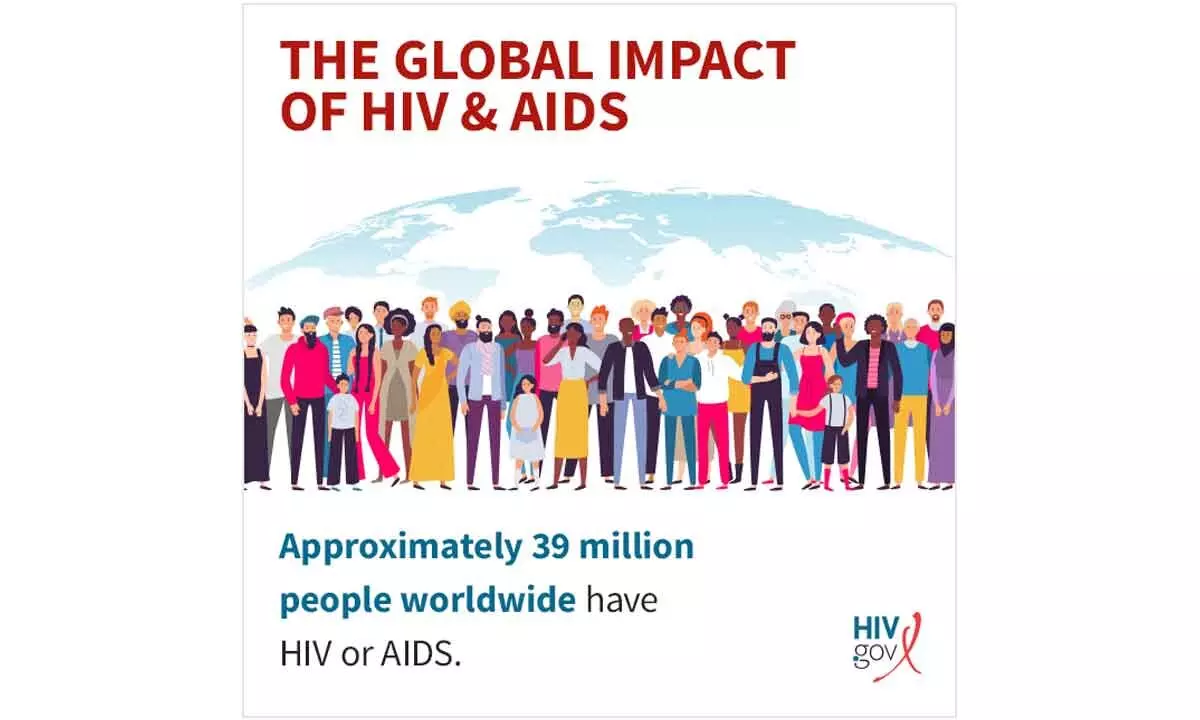India has the second largest HIV epidemic in world
Early detection, timely intervention and treatment improve PLHIV’s quality of life
image for illustrative purpose

India has the second largest HIV epidemic in the world, accounting for around 6.3 per cent of all PLHIV worldwide.
As per an estimate, 38 million people worldwide are living with HIV/AIDS, of which 2.3 million are in India alone. As HIV vaccine remains elusive, the significance of early diagnosis and linkage to care for People Living with HIV (PLHIV) cannot be overstated.
Early detection allows for timely intervention and treatment, which can significantly improve health outcomes and quality of life for PLHIV. Moreover, proper linkage to care ensures that individuals receive comprehensive medical attention. It also facilitates ongoing monitoring of the virus's progression, management of symptoms, and prevention of opportunistic infections.
The early diagnosis and linkage to care have significantly improved the lives of millions of individuals like Ranjita Devi (name changed), whose life took a turn for the worst in February 2023. At one of the screening camps in Samastipur, organized by Palladium as part of the Community Based HIV Testing and Linkage (CBHTL) project by AHF India Cares, she tested positive for HIV.
As part of the National HIV Counseling and Testing protocol, Ranjita underwent a confirmatory test at the nearest Integrated Counseling and Testing Centre. The results were perplexing – while kit 1 showed a negative outcome, kit 2 displayed a positive result. Seeking clarity, Ranjita was referred to a hospital in Muzaffarpur for another confirmatory test. However, even after repeated tests, the outcome remained unchanged, plunging Ranjita deeper into despair.
Recognizing the urgency of the situation, the Palladium team reached out to the ICTC Counselor at the District Hospital, initiating a chain of consultations for determining the correct diagnosis. With the intervention of Bihar SACS, an Eliza test was conducted at the blood bank in Samastipur. Finally, Ranjita underwent the confirmatory test in January 2024, which conclusively confirmed her diagnosis. Ranjita was immediately put on treatment.
The correct and early diagnosis and subsequent linkage to care were crucial in Ranjita's journey. With the support of healthcare professionals and compassionate guidance from the ART Center doctors, she understood that HIV is not the end of the world. She gained a deeper understanding of the pervasive taboo surrounding HIV, recognizing the complex societal attitudes and misconceptions that contribute to discrimination and marginalization of those living with the virus. Today Ranjita is living a healthy life and spreads awareness around her about HIV.
With around 24.67 lakh (20.84-29.52 lakh) people living with HIV (PLHIV), India has the second largest HIV epidemic in the world, accounting for around 6.3 per cent of all PLHIV worldwide, as per Sankalak (Vth Edition), 2023- NACO.
Talking to Bizz Buzz, Amit Patjoshi, CEO, Palladium India says, “CBHTL has undertaken substantive endeavours to address some core challenges”.
Societal stigma and discrimination pose significant barriers to testing and information access, which were mitigated through comprehensive counseling sessions and engagement with HIV community members for open communication, he said.
Limited access to testing facilities in remote or marginalized areas necessitates tailored field-testing plans informed by data analysis to ensure maximum coverage. Insufficient knowledge about HIV transmission and prevention was tackled by providing field teams with training on cultural sensitivity and socioeconomic barriers, facilitating comprehensive education efforts, he added.
Despite the provision of free HIV testing and treatment by the government, transportation expenses represent an out-of-pocket expenditure, which some individuals may find unaffordable. In instances where individuals face financial constraints, the field team facilitated transportation to ensure access to these facilities.
The project has achieved significant strides in engaging with the hard-to-access demographic and encompasses population groups outside the purview of the National Programme. Carefully selected field teams with expertise in HIV community interventions are pivotal for reaching the target population for testing. These teams understand the local demographics, fostering rapport and mobilization for testing. The project ensures a 100 per cent referral rate to ICTCs for positive cases. Field teams facilitate uninterrupted treatment initiation by linking clients to ART centers, employing an accompanied referral mechanism to minimize loss of linkage. The continuous training of field teams in counseling skills has led to the provision of high-quality counseling services to clients. Lastly, collaboration with State AIDS Control Societies (SACS) and frontline functionaries has facilitated the seamless implementation of the project.
The National AIDS and STD Control Programme (NACP) phase-V sets forth ambitious objectives aiming for the achievement of the 95-95-95 targets by 2025, encompassing the goals wherein 95% of all individuals living with HIV are aware of their HIV status, 95 per cent of all individuals diagnosed with HIV infection receive sustained antiretroviral therapy (ART), and 95 per cent of all individuals receiving antiretroviral therapy attain viral suppression by the specified deadline. Community-Based HIV Testing is identified as a pivotal strategy by the NACP to realize the first 95 target.
The project is currently implemented in 25 sites across Delhi, Maharashtra, Bihar, Uttar Pradesh, Madhya Pradesh, Andhra Pradesh, Telangana, Mizoram and Meghalaya and envisions maximizing efforts towards attaining the 95-95-95 objectives by expanding testing sites and reaching out to the uncovered population.
HIV care means embracing early diagnosis and treatment, empowering individuals to take control of their health, and fostering a community of support and compassion. Together, we can break barriers, save lives, and build a healthier and brighter future.

